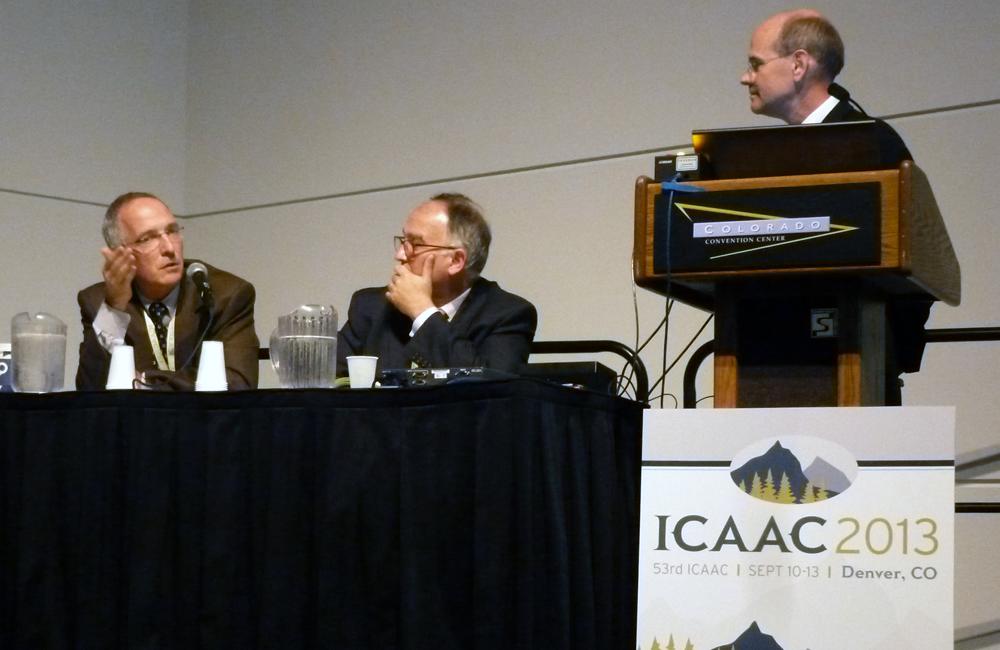
Blood levels of MK-1439, a next-generation HIV non-nucleoside reverse transcriptase inhibitor (NNRTI) in phase 2b trials, rose significantly when combined with ritonavir, but tenofovir had little effect, researchers reported at the 53rd Interscience Conference on Antimicrobial Agents and Chemotherapy (ICAAC) last week in Denver.
Matt Anderson from Merck presented findings from a study looking at interactions between MK-1439 and two widely used antiretrovirals, ritonavir (Norvir) and tenofovir disoproxil fumarate (Viread, also in the Truvada, Atripla, Eviplera and Stribild co-formulations).
In studies to date, MK-1439 has shown good antiviral potency, safety and tolerability. MK-1439 works well against NNRTI-resistant viruses with the K103N, Y181C and G190A mutations. At this year's Conference on Retroviruses and Opportunistic Infections (CROI 2013), Anderson reported that MK-1439 demonstrated robust activity and good tolerability as monotherapy in a small phase 1b trial and had minimal central nervous system (CNS) toxicity – a common concern with efavirenz.
MK-1439 is primarily metabolised by oxidation via the CYP3A4 enzyme in the liver, which may lead to interactions with other drugs processed by the same pathway. Early pharmacokinetic studies suggested MK-1439 did not inhibit or significantly induce drug-metabolising CYP enzymes, and it did not meaningfully alter midazolam levels.
Conversely, researchers wanted to know if other antiretroviral drugs that act as CYP3A4 inhibitors or inducers would have clinically significant effects on MK-1439. CYP3A4 inhibitors slow drug processing, which can lead to higher concentrations and intensified side-effects. This is the principle behind "boosting" other antiretrovirals with the potent CYP3A4 inhibitors ritonavir or cobicistat. CYP3A4 inducers, in contrast, speed up processing and can lead to low drug levels that do not adequately control viral replication.
Ritonavir is both a strong inhibitor and an inducer of CYP3A4. Tenofovir has more "idiosyncratic interaction potential" that does not follow a consistent pattern, the researchers noted as background.
Merck investigators performed two open-label, fixed-sequence studies – one for ritonavir, one for tenofovir – each enrolling eight healthy HIV-negative volunteers. All were men and ages ranged from 21 to 50 years.
In the ritonavir study, during the first period participants received a single 50mg dose of MK-1439. During the second period, after a seven-day washout, they received 100mg twice-daily ritonavir for 20 days, with a second single 50mg dose of MK-1439 taken with the morning ritonavir dose on day 14.
In the tenofovir study, during the first period volunteers received a single 100mg dose of MK-1439. During the second period, again after a seven-day washout, they received 300mg once-daily tenofovir for 18 days, with a second single 100mg dose of MK-1439 taken with tenofovir on day 14.
Blood samples were collected before and after dosing during each period. Researchers measured pharmacokinetic parameters including overall plasma concentration (area under the curve, or AUC), 24-hour minimum or trough concentration (C24hr), maximum concentration (Cmax), time to reach maximum concentration (Tmax) and half-life, or time needed to eliminate half the drug. They also evaluated adverse events, vital signs, electrocardiograms (ECGs) and laboratory safety values.
All participants in the ritonavir study and all but one in the tenofovir study completed the trials. That individual stopped due to diverticulitis, which was considered not related to the study drug.
No serious adverse events or CNS side-effects were seen in either study. Most participants reported mild to moderate adverse events of limited duration (eight in the ritonavir study, four in the tenofovir study), a majority of which were deemed possibly drug-related. No significant effects on vital signs, ECGs or laboratory safety measurements were observed.
Co-administration with ritonavir approximately tripled overall AUC and trough concentrations of MK-1439, although the maximum concentration only rose by about 30% (geometric mean ratios 3.54, 2.91 and 1.31, respectively). Time to reach Cmax increased from 3.5 to 5.0 hours, whilst the apparent half-life more than doubled, from 13.9 to 34.9 hours.
These findings "[suggest] that ritonavir has a limited effect on MK-1439 bioavailability and absorption, but a significant effect on MK-1439 elimination, due to inhibition of CYP3A4," the researchers concluded.
Co-administration with tenofovir, in contrast, had little effect on MK-1439 levels. AUC and C24hr concentrations of MK-1439 remained about the same, with a small decrease in Cmax (geometric mean ratios 0.97, 0.95 and 0.82, respectively). Tmax (2.5 vs 3.0 hours) and apparent half-life (14.4 vs 15.8 hours) were also similar.
"Co-administration with MK-1439 has no clinically meaningful effect on the pharmacokinetics of MK-1439," according to the researchers.
Responding to audience questions, Anderson indicated that the clinical dose of MK-1439 has not yet been decided. He added that it is not yet clear whether dose adjustment will be required when using MK-1439 with ritonavir or cobicistat. "We need to know the clinical bounds of meaningful change – not just pharmacokinetics – which will come from clinical trials," he said.
Anderson M et al. Effect of ritonavir and tenofovir on the pharmacokinetics of MK-1439, a novel HIV-1 non-nucleoside reverse transcriptase inhibitor (NNRTI). 53rd Interscience Conference on Antimicrobial Agents and Chemotherapy, Denver, abstract H-1462, 2013. View the abstract on the ICAAC website.
